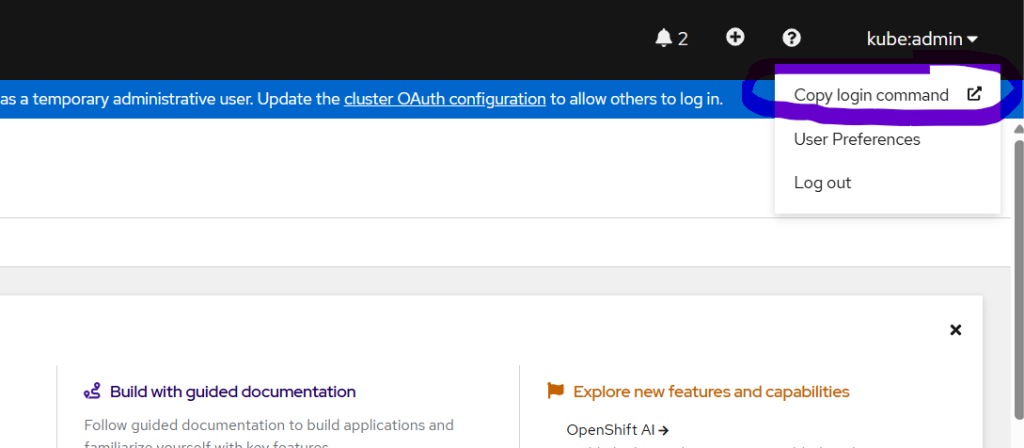How to login?
oc login https://api.XXXXXXXXXXXXXX.centralindia.aroapp.io:6443 --username=kubeadmin --password=EgzIY-DJPw2-3NXke-HNYmJ
oc login --token=sha256~LLnTlPcjcNjWsQRqnSyTn99LSvxwQdm47gaiEdZJa20 --server=https://api.XXXXXXXXXXXXXX.centralindia.aroapp.io:6443
curl -H "Authorization: Bearer sha256~LLnTlPcjcNjWsQRqnSyTn99LSvxwQdm47gaiEdZJa20" "https://api.XXXXXXXXXXXXXX.centralindia.aroapp.io:6443/apis/user.openshift.io/v1/users/~Code language: JavaScript (javascript)
Login to the Web Console and CLI on CRC
crc console --credentials
eval $(crc oc-env)
oc login -u kubeadmin -p <password> --insecure-skip-tls-verify
Code language: JavaScript (javascript)Copy the admin URL and kubeadmin credentials → open in browser.
✅ Step 2: Understand Projects (Namespaces)
🔹 List All Projects:
oc get projects
Code language: JavaScript (javascript)🔹 Create Your Own:
oc new-project demo-app
Code language: JavaScript (javascript)✅ Step 3: Deploy Your First Application
oc get images
oc new-app --name=my-java-app registry.access.redhat.com/ubi8/openjdk-8-runtime@sha256:00cf28cf9a6c427962f922855a6cc32692c760764ce2ce7411cf605dd510367f
oc expose svc/my-java-app
oc get imagestreams -n openshift
oc new-app --name=my-httpd --image-stream=openshift/httpd
oc expose svc/my-httpd
oc get route my-httpdCode language: JavaScript (javascript)Test in browser using the exposed route.
✅ Step 4: Work with the Developer Console
- Go to the Web Console → Developer View
- Switch to
demo-appproject - Click +Add → Use “Container Image”
- Search for image like
node:latest,php:8.2-apache, orquay.io/...
This gives visual understanding of how apps, builds, and deployments connect.
✅ Step 5: Build from Source (Git to Deployment)
🔹 Deploy from Git (Node.js example):
oc new-app https://github.com/sclorg/nodejs-ex.git
Code language: JavaScript (javascript)🔹 Monitor:
oc get builds
oc logs -f bc/nodejs-ex
Code language: JavaScript (javascript)🔹 Access:
oc expose svc/nodejs-ex
oc get route
Code language: JavaScript (javascript)✅ Step 6: Scale Applications
🔹 Increase Pods:
oc scale --replicas=3 deployment/nginx
🔹 Check Pods:
oc get pods -o wide
Code language: JavaScript (javascript)✅ Step 7: Access Pod Shell & Logs
oc rsh <pod-name>
oc logs <pod-name>
Code language: HTML, XML (xml)Use this for debugging and viewing container state.
✅ Step 8: Set Resource Limits
oc set resources deployment nginx \
--limits=cpu=500m,memory=256Mi \
--requests=cpu=200m,memory=128Mi
Code language: JavaScript (javascript)✅ Step 9: Understand and Apply YAML
- Export a deployment:
oc get deployment nginx -o yaml > nginx.yaml - Edit and apply:
oc apply -f nginx.yaml
✅ Step 10: Use Secrets and ConfigMaps
🔹 Create ConfigMap:
oc create configmap app-config --from-literal=ENV=prod
Code language: JavaScript (javascript)🔹 Create Secret:
oc create secret generic app-secret --from-literal=DB_PASS=admin123
Code language: JavaScript (javascript)🔹 Mount or Inject via ENV in deployment YAML.
✅ Step 11: OpenShift Pipelines (Tekton)
- In OperatorHub, install OpenShift Pipelines Operator
- Create:
- PipelineResource
- Task
- Pipeline
- Use the developer console’s Pipelines view to build CI/CD
✅ Step 12: Monitor with Web UI
- Use Observe → Metrics
- View Dashboard, Topology, and Builds
- Use Pod terminal from console
✅ Step 13: Delete a Project
oc delete project demo-app
Code language: JavaScript (javascript)📚 Bonus Tips:
| Feature | CLI Command |
|---|---|
| List all Pods | oc get pods |
| View events | oc get events |
| Port Forward | oc port-forward svc/nginx 8080:80 |
| RoleBinding | oc adm policy add-role-to-user admin developer |
| Enable Dev View | Use toggle in OpenShift console UI |
🧪 Practice Ideas:
- Deploy a multi-container app with
mysql+wordpress - Create blue-green deployments
- Use Tekton pipeline to auto-deploy from GitHub
To deploy an image in OpenShift using the openshift/httpd image, and configure different Kubernetes resources such as StatefulSets, Secrets, ConfigMaps, CronJobs, Jobs, DaemonSets, and HPA, here are the YAML configurations and relevant commands for each.
apiVersion: apps/v1
kind: Deployment
metadata:
name: httpd-deployment
spec:
replicas: 1
selector:
matchLabels:
app: httpd
template:
metadata:
labels:
app: httpd
spec:
containers:
- name: httpd
image: openshift/httpd
ports:
- containerPort: 80Command to deploy:
oc apply -f httpd-deployment.yamlapiVersion: apps/v1
kind: StatefulSet
metadata:
name: httpd-statefulset
spec:
serviceName: "httpd"
replicas: 3
selector:
matchLabels:
app: httpd
template:
metadata:
labels:
app: httpd
spec:
containers:
- name: httpd
image: openshift/httpd
ports:
- containerPort: 80Command to deploy:
oc apply -f httpd-statefulset.yamlapiVersion: v1
kind: Secret
metadata:
name: httpd-secret
type: Opaque
data:
password: cGFzc3dvcmQ= # base64 encoded passwordCommand to create a secret:
oc apply -f httpd-secret.yamlapiVersion: v1
kind: ConfigMap
metadata:
name: httpd-config
data:
httpd.conf: |
ServerName localhost
DocumentRoot /var/www/htmlCommand to create a config map:
oc apply -f httpd-config.yamlapiVersion: batch/v1
kind: CronJob
metadata:
name: httpd-cronjob
spec:
schedule: "*/5 * * * *" # Every 5 minutes
jobTemplate:
spec:
template:
spec:
containers:
- name: httpd
image: openshift/httpd
restartPolicy: OnFailureCommand to deploy a cron job:
oc apply -f httpd-cronjob.yamlapiVersion: batch/v1
kind: Job
metadata:
name: httpd-job
spec:
template:
spec:
containers:
- name: httpd
image: openshift/httpd
restartPolicy: NeverCommand to deploy a job:
oc apply -f httpd-job.yamlapiVersion: apps/v1
kind: DaemonSet
metadata:
name: httpd-daemonset
spec:
selector:
matchLabels:
app: httpd
template:
metadata:
labels:
app: httpd
spec:
containers:
- name: httpd
image: openshift/httpd
ports:
- containerPort: 80Command to deploy a daemon set:
oc apply -f httpd-daemonset.yamlapiVersion: autoscaling/v2
kind: HorizontalPodAutoscaler
metadata:
name: httpd-hpa
spec:
scaleTargetRef:
apiVersion: apps/v1
kind: Deployment
name: httpd-deployment
minReplicas: 1
maxReplicas: 10
metrics:
- type: Resource
resource:
name: cpu
target:
type: Utilization
averageUtilization: 50Command to deploy HPA:
oc apply -f httpd-hpa.yamlTo deploy each of the above resources, use the following commands:
-
Deployment:
oc apply -f httpd-deployment.yaml
-
StatefulSet:
oc apply -f httpd-statefulset.yaml
-
Secrets:
oc apply -f httpd-secret.yaml
-
ConfigMap:
oc apply -f httpd-config.yaml
-
CronJob:
oc apply -f httpd-cronjob.yaml
-
Job:
oc apply -f httpd-job.yaml
-
DaemonSet:
oc apply -f httpd-daemonset.yaml
-
Horizontal Pod Autoscaler:
oc apply -f httpd-hpa.yaml
These YAML files and commands cover the most common Kubernetes resources you may need while deploying an image on OpenShift. Adjust the values (e.g., replicas, resources, image, etc.) as needed for your use case.
I’m a DevOps/SRE/DevSecOps/Cloud Expert passionate about sharing knowledge and experiences. I am working at Cotocus. I blog tech insights at DevOps School, travel stories at Holiday Landmark, stock market tips at Stocks Mantra, health and fitness guidance at My Medic Plus, product reviews at I reviewed , and SEO strategies at Wizbrand.
Do you want to learn Quantum Computing?
Please find my social handles as below;
Rajesh Kumar Personal Website
Rajesh Kumar at YOUTUBE
Rajesh Kumar at INSTAGRAM
Rajesh Kumar at X
Rajesh Kumar at FACEBOOK
Rajesh Kumar at LINKEDIN
Rajesh Kumar at PINTEREST
Rajesh Kumar at QUORA
Rajesh Kumar at WIZBRAND

